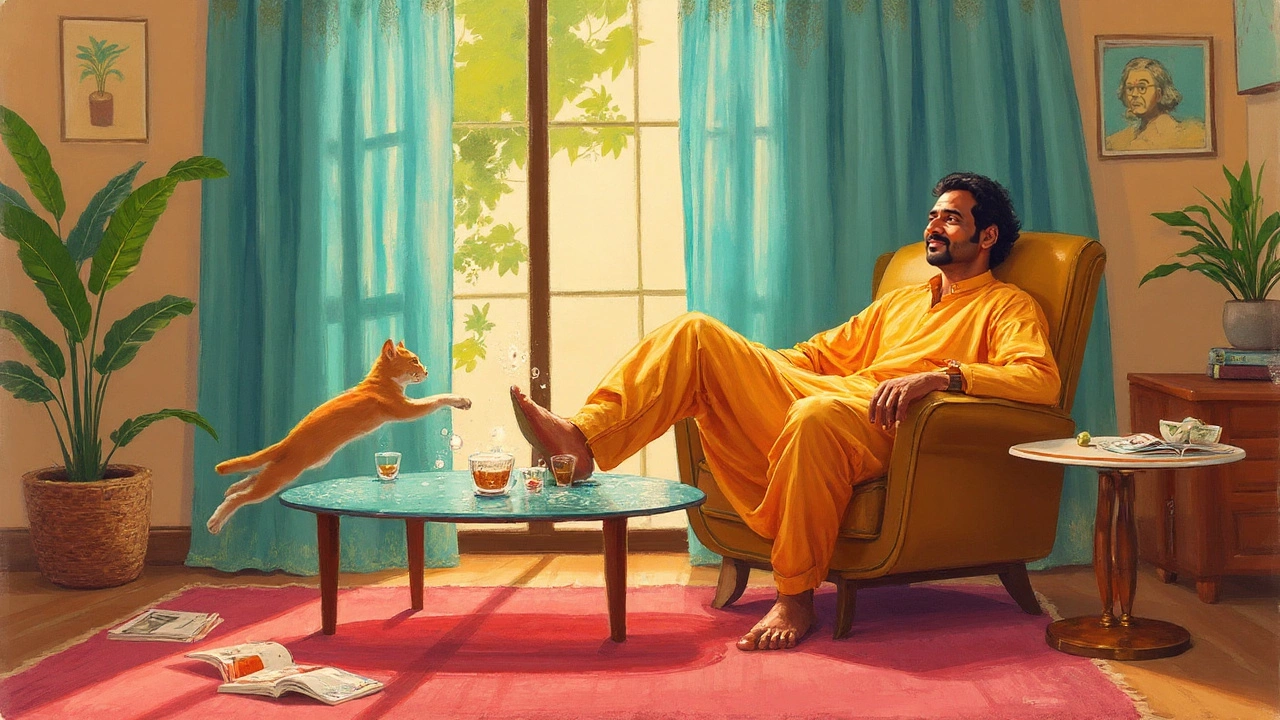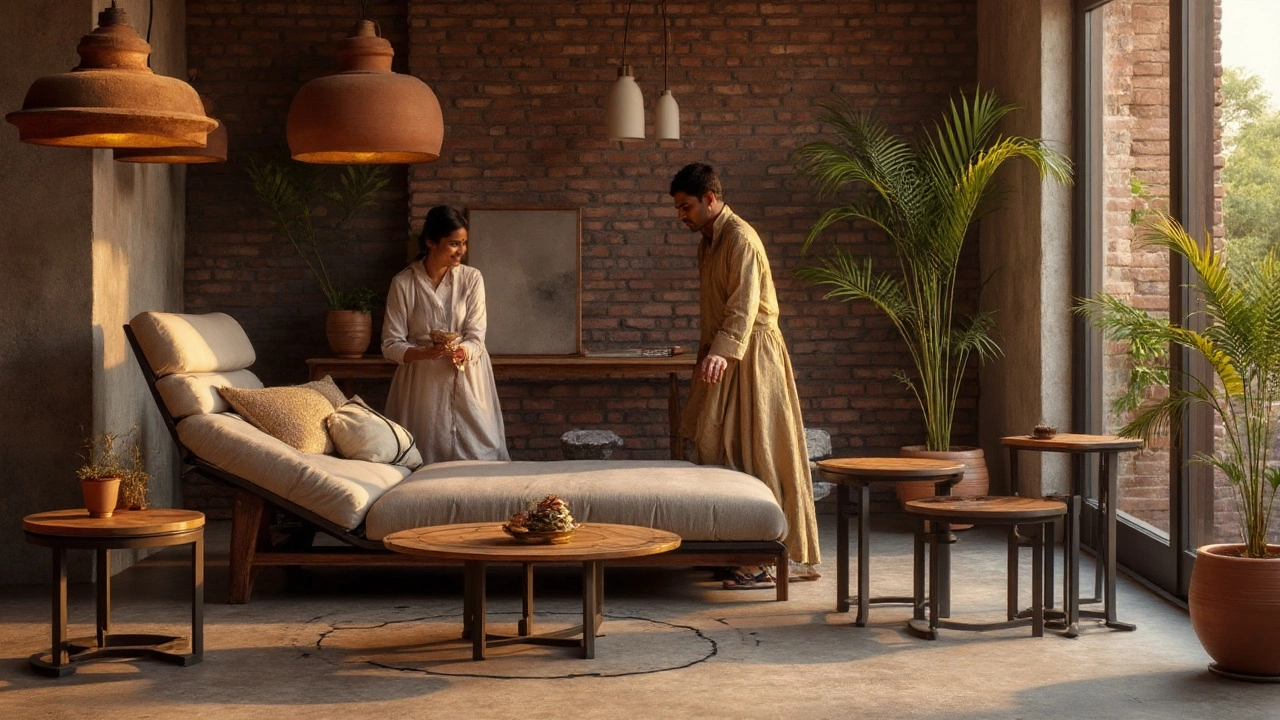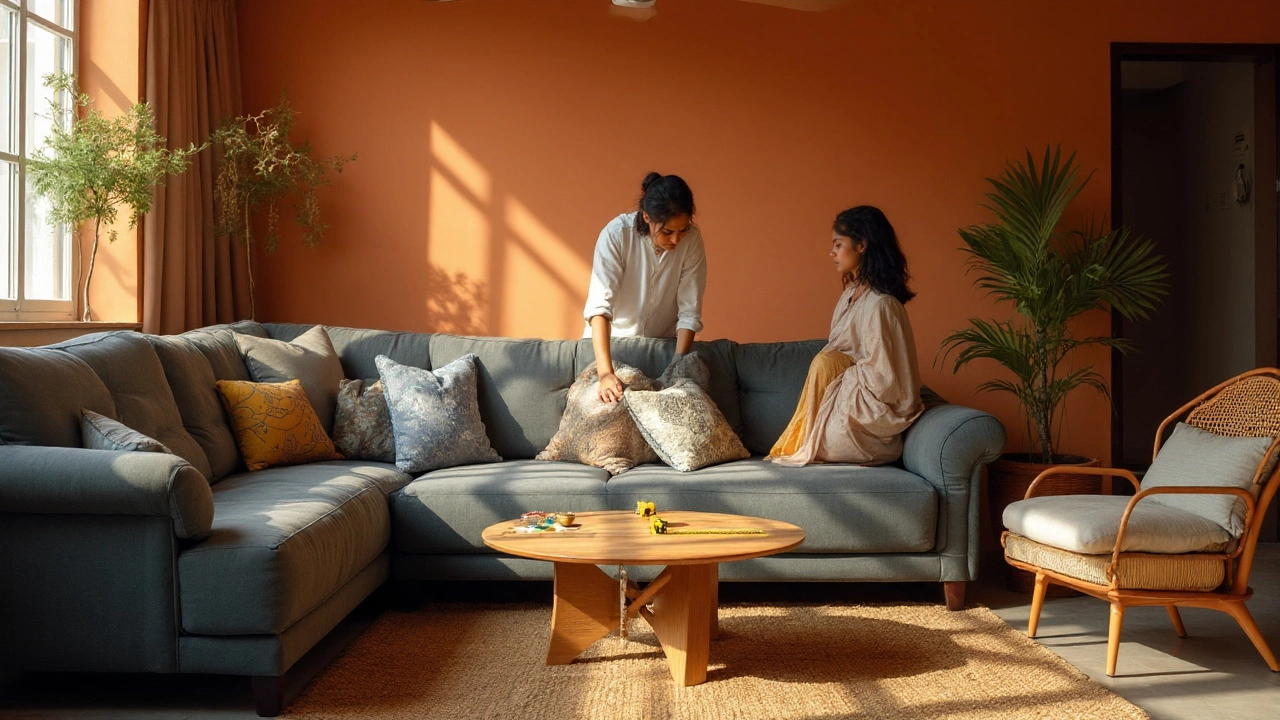Choose the wrong table for a recliner and you’ll bang shins, block footrests, and hate movie night. Choose the right one and the room just works-feet up, snacks close, nothing in the way. Here’s a straight answer: you need a table that clears the footrest, sits just below seat height, and doesn’t trap the walkway. I’ve measured more living rooms than I can count, and the same rules keep saving people from returns and dents.
- Height rule: 1-2 inches below your recliner’s seat height (usually 17-20 inches seat, so 16-18 inches table).
- Length rule: 60-70% of the sofa width, but keep space for the footrest and walk paths.
- Clearance rule: leave 20-24 inches from the sofa edge to the table edge when the footrest is extended.
- Best shapes: rounded rectangle, oval, or soft ottoman with a tray. Lift-top tables solve the eating/typing angle.
- Small rooms: use a slim oval or two nesting/C-tables instead of one big block.
Sizing and Placement: The Rules That Make Recliners Behave
Before you scroll past the measurements, remember: reclining changes everything. A standard sofa doesn’t move. A reclining sofa grows a metal foot that needs breathing room. These quick rules prevent bruises and buyer’s remorse.
Start with the reality check. Sit down, extend the footrest, and look at the floor-how far out does the footrest land? That “recline footprint” is the number most people skip, and it’s why tables end up with chipped corners.
Use these simple formulas:
- Table height (H): seat height minus 1-2 inches. If your seat is 19 inches, aim for a 17-18 inch table.
- Table length (L): about 60-70% of sofa width. On an 84-inch sofa, you’re in the 50-59 inch range-unless the room is tight, then go shorter or split into two pieces.
- Front clearance (C): 20-24 inches from the sofa’s front edge to the table edge when the footrest is extended.
- Walkway (W): keep 30-36 inches around the outside edges so people can pass without turning sideways. I use 36 inches as the “gold” standard since that matches accessible route guidance (36 inches) from ADA standards.
That clearance number-20 to 24 inches-sounds generous until the recliner pops. Manual recliners often kick further than power ones, so mock it up: extend the footrest, place painter’s tape where it ends, then measure backward to the sofa. That’s your no-go zone for the coffee table edge.
Seat height matters. Most recliner seats land around 18-20 inches off the floor according to 2024 product sheets from big brands. The right table height keeps your wrist neutral when you reach for a glass. Too tall and you’ll knock it. Too short and you’ll tip over to grab things.
Shape is your shin guard. Rounded rectangles and ovals let you slide by without snagging fabric or knees. Square boxes work with non-reclining sofas; with recliners, their corners sit right where your shins want to pass.
Materials and edges: If kids or pets live here, look for a bullnose or eased edge (at least 3-5 mm radius). Tempered glass is strong, sure, but corners still hurt, and smudges show. Upholstered ottomans with a tray are the friendliest surface in small rooms-they forgive bumps and double as seating.
Power cords and floor vents: Power recliners bring cords. Run them under the sofa and out the back if you can, or use a low-profile floor cable cover. Avoid placing a low solid-base table directly over a floor vent; airflow matters, especially with HVAC running more in 2025 heat waves.
Casters are handy, but lock them. If you choose a rolling table, make sure at least two wheels lock. Recliners push forward; a table that moves with them can clip toes when it rolls back.
Here’s a quick sizing cheat table I use when clients send measurements. Always verify your own room-this is a starting point, not a law.
| Sofa width | Suggested table length | Table height target | Clearance to sofa front (footrest out) | Walkway around table |
|---|---|---|---|---|
| 72 in (183 cm) | 43-50 in (109-127 cm) | 16-18 in (41-46 cm) | 20-22 in (51-56 cm) | 30-36 in (76-91 cm) |
| 84 in (213 cm) | 50-59 in (127-150 cm) | 16-18 in (41-46 cm) | 20-24 in (51-61 cm) | 30-36 in (76-91 cm) |
| 96 in (244 cm) | 58-67 in (147-170 cm) | 16-18 in (41-46 cm) | 22-24 in (56-61 cm) | 32-40 in (81-102 cm) |
| Sectional w/ chaise | Half the long side, or two small tables (22-28 in each) | 16-18 in (41-46 cm) | 20-24 in (51-61 cm) | 30-36 in (76-91 cm) |
How to place it without guesswork:
- Recline fully and tape the footrest edge on the floor.
- Measure 20-24 inches back from that tape line and mark your max table edge.
- Measure seat height and pick a table 1-2 inches lower.
- Check walkways: you need 30-36 inches around the outside where people pass.
- Mock with cardboard: cut the table footprint to size and live with it for a day. If you can pass with a bowl of popcorn and not flinch, it’s right.
Bonus tip for small rooms: break the coffee table into two pieces. Two 20-24 inch rounds or a round plus a C-table give you flexibility. Slide one out when the recliner opens, and bring it back when you need the surface.

The Best Coffee Table Types for Reclining Sofas (and When to Use Each)
Different rooms need different tools. Here’s what works with recliners and why-plus what to watch out for.
- Lift-top coffee table
Best for: eating, laptops, and anyone who wants the surface closer when reclined.
Watch out: heavy lids. Look for soft-close hinges and counterbalance hardware so it doesn’t slam or pinch. Check lift height-10-12 inches is useful; 6 inches isn’t. - Rounded rectangle or oval table
Best for: medium to large rooms where you still want smooth traffic. Rounded corners save shins when you slide in or stand up while the footrest is out.
Watch out: length creep. It’s easy to oversize. Stick to the 60-70% rule. - Upholstered ottoman + tray
Best for: family rooms, kids, pets, and comfort-first spaces. It’s the softest option and great for extra seating.
Watch out: low height. Make sure the ottoman is at least 15-17 inches tall so a tray sits at a usable level. Use a large rigid tray (18-24 inches) for cup stability. - Nesting tables (two or three)
Best for: tight layouts and multi-use rooms. Pull one close when reclining; tuck them back after.
Watch out: odd heights. Keep the tallest nest at your target height range. If the smaller one is too low, it becomes decor, not function. - C-tables (one per seat is clutch)
Best for: small spaces or deep recline users who want a surface literally over the lap.
Watch out: base clearance. The foot of the C must slide under the sofa without hitting the recliner mechanism. Measure the gap under your sofa frame-aim for a base that’s 0.5-1 inch shorter than that clearance. - Split coffee tables (two small ovals or drums)
Best for: sectional recliners and U-shaped seating. They reconfigure on movie nights.
Watch out: tipping. Drums are stable; tiny pedestal tables are not. - Waterfall bench table (narrow, long, rounded edges)
Best for: minimalist rooms. It tucks under footrests better than bulky storage tables.
Watch out: no hidden storage and can be too long if you don’t measure. - Storage table with side drawers
Best for: remotes, chargers, and coasters. Side-access drawers keep the front clear for footrests.
Watch out: front drawers that slam into the footrest when you forget and open them while reclined.
Material picks that make sense:
- Solid wood or plywood core with veneer: strong edges, can be rounded easily. Ask for a 3 mm or larger edge radius.
- Rattan/woven or upholstered sides: kinder to knees in tight rooms.
- Tempered glass: use it when you need visual lightness, but choose rounded edges and a metal frame with rubber bumpers. Check the glass thickness-8-10 mm is a good sweet spot for stability.
- Metal frames: great for slim legs and robot vac clearance. Pad the corners if they’re sharp.
Scenarios and what I’d pick:
- Small living room, 80-inch sofa, every inch counts: a 44-48 inch oval, 17 inches high, or two 22-inch rounds you can park apart when the recliner opens.
- Home theater setup, long sessions, snacks and laptops: a lift-top with soft-close hardware and a back rail that clears knees when you raise it.
- Kids + pets, no broken glass allowed: a 36-40 inch square ottoman with a big tray, or a 48-inch rounded rectangle with bullnose edges.
- Power recliner with limited under-sofa clearance: skip deep C-tables with thick bases; pick a thin flat base (steel plate under 0.25 inch) or use a nesting set.
- Sectional with chaise: split tables-two ovals or an oval + drum. If you try one giant table, it will block someone’s footrest.
- Very narrow room: run a slim waterfall bench (14-16 inches deep) and add a C-table per seat on movie nights.
- Wheelchair visitor sometimes: leave one side path at 36 inches minimum and use a movable table with locking casters to open the route fast.
Decision guide in one minute:
- If you recline fully a lot and eat/work at the sofa → lift-top.
- If the room is tight → oval or two small rounds/nesting tables.
- If you want the safest edges → upholstered ottoman + tray.
- If your recliner sits low and you need reach → C-table with a thin base.
- If you need hidden storage → side-drawer table or lift-top with interior bins.

Checklists, Mistakes to Avoid, Mini‑FAQ, and Next Steps
Use these checklists when you’re shopping so you don’t fall for a pretty table that fights your recliner.
Pre‑shopping measurement checklist:
- Seat height (to top of cushion): ____ inches → target table height = seat height minus 1-2 inches.
- Sofa width (arm to arm): ____ inches → target table length = 60-70% of that.
- Footrest footprint: reclined, tape the edge → leave 20-24 inches back to the table.
- Walkway paths: keep 30-36 inches clear on the sides.
- Under‑sofa clearance: ____ inches → choose C‑tables/bases that fit under this height.
- Vent/cable locations: mark them so your table base doesn’t block airflow or snag cords.
Delivery and fit plan:
- Max door/turn clearance on the delivery path: measure your narrowest point.
- Weight check: lift-top mechanisms add weight-make sure you can slide or roll it for cleaning.
- Rug test: if you have a rug, leave at least 6-10 inches of rug visible around the table so the room doesn’t feel crowded.
Styling and safety tips that still respect function:
- Rounded edges beat sharp corners for recliners-every time.
- Choose coasters with a soft underside if you’re using a tray on an ottoman.
- If you love glass, pick frosted or extra-clear tempered glass with rounded corners to cut glare and fingerprints.
- Hide cables with a braided sleeve that matches the floor color; most sleeve kits handle 2-3 cords.
- Robot vacuum owner? Aim for a table with legs at least 4 inches off the floor or a base the bot can’t wedge under.
Common mistakes to skip:
- Buying by looks only. Recline footprint always comes first.
- Too tall. Anything taller than the seat makes reaching awkward and increases spill risk.
- Front-opening drawers. They smash into footrests. Go side drawers or no drawers.
- Sharp glass corners. They find knees. Rounded or beveled edges are worth it.
- Ignoring pathways. If someone has to turn sideways to pass, the table is wrong for the room.
Mini‑FAQ
- What is the best coffee table height for a reclining sofa?
1-2 inches lower than your seat height. If your seat is 19 inches, choose 17-18 inches. - How far should the coffee table be from the sofa with a recliner?
20-24 inches when the footrest is out. Measure it taped on the floor to be sure. - Round, oval, or rectangle-what’s better?
For recliners, rounded rectangle or oval is the sweet spot. Rounds are great split into pairs; a single small round can feel undersized on a long sofa. - Is glass safe with recliners?
Yes, if tempered and with rounded edges, but it shows smudges and feels cold. Use if you need visual lightness; otherwise wood or an upholstered ottoman is friendlier. - Can I skip a coffee table and use only side tables?
You can. Two sturdy C-tables and a slim side table can replace a center table in tight rooms. Make sure the C-table base fits under your sofa frame. - What size rug works with a recliner and coffee table?
Keep the front legs of the sofa on the rug and leave 6-10 inches of rug beyond the coffee table on all sides for balance. - Do lift-top tables wobble?
Good ones don’t. Look for dual-arm mechanisms, cross-bracing, and soft-close. If the top flexes when you press the corner in the showroom, skip it.
Troubleshooting by situation
- The footrest hits the table you already own.
Short-term: slide the table 2-4 inches forward and angle it slightly. Long-term: either shorten the table depth (choose 18-22 inches deep) or split into two smaller tables you can reposition on movie nights. - No room for a walkway on one side.
Swap a single big table for two small ovals or a nesting set and leave a 36-inch clear route on the main traffic side. - Table feels too low for eating or typing.
Add a lift-top or keep a C-table with a 24-26 inch top height to slide over your lap. - Power cords are ugly and in the way.
Route under the sofa, out the rear leg. Use a flat cable cover if it must cross under the table, color-matched to the floor. - Kids keep bumping corners.
Add corner guards now, then replace with a rounded-edge table or upholstered ottoman when it’s in budget. - Robot vacuum keeps getting stuck.
Block the gap under low solid bases with adhesive foam or pick a table with legs higher than 4 inches.
Quick shopping checklist you can screenshot:
- Height: seat height minus 1-2 inches.
- Length: 60-70% of sofa width.
- Clearance: 20-24 inches from sofa to table with footrest out.
- Walkway: 30-36 inches around outside edges.
- Edges: rounded/soft preferred.
- Type: lift-top, oval, ottoman + tray, nesting, or C-tables as needed.
- Base: won’t block vents, fits C-table foot if you use one.
- Hardware: soft-close hinges, locking casters if it rolls.
If you stick to those numbers, you’ll avoid 90% of the headaches I see with recliners. Measure once while the footrest is open, and every choice after that gets easier. Comfort first, movement second, style third-and you can absolutely have all three.

